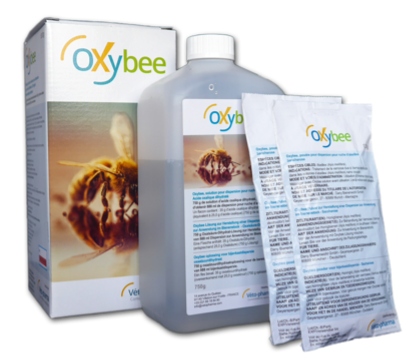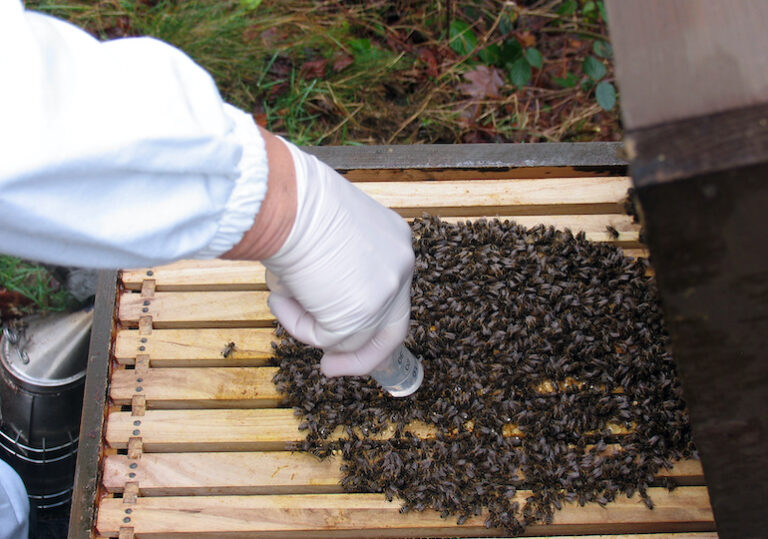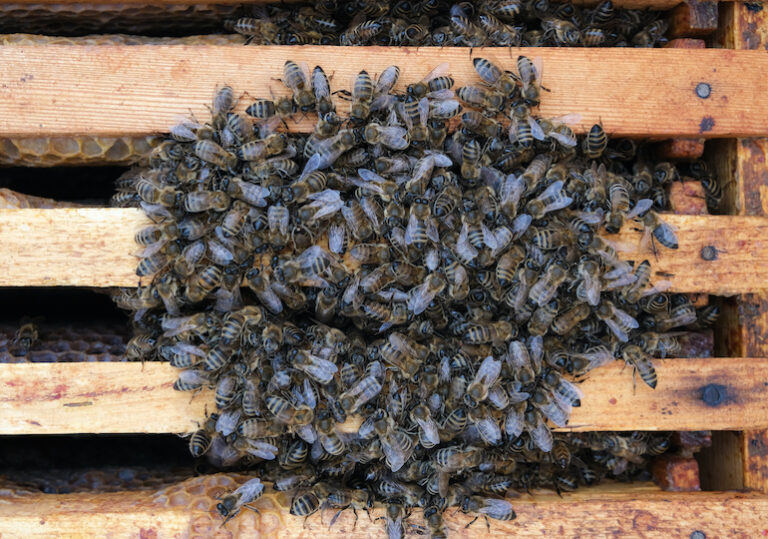 Véto-pharma
Véto-pharma Things can get pretty rough for bees in winter, but in the face of adversity, these creatures – quite literally – come together to form what is known as the “winter cluster” in honey bee biology. In autumn or winter, as soon as the temperature drops to below 10°C, bees prefer to stay inside the hive and sit closely together, forming a cluster around the queen. Only a few insects, such as ants and honeybees, can survive the winter as a colony.
The winter cluster becomes tighter and more compact as the ambient temperature drops further. The bees inside the hive cling to each other closely. Regardless of weather conditions, the temperatures within the winter cluster stay very warm at ca. 25-30°C. Clusters that are larger (basketball size) have a better chance of surviving the winter than smaller clusters (softball size).
It is this important milestone (winter survival) that we can support as beekeepers to keep our bees healthy and ensure their safe transition into the following spring.
You have most likely heard of varroa mites, one of the biggest threats to honey bee colonies. In winter, mite infestation can be a major trigger, as the bees will be more vulnerable to the parasitic load. If the infestation is high at the beginning of winter and nothing is done to decrease it, their chances of survival can dramatically drop.
The Véto-pharma team, reminiscent of honey bees in a hive, is working together to ensure bee health and is happy to inform you of the availability of Oxybee, a highly efficient varroa treatment, suitable for organic beekeeping.1

Oxybee is an oxalic acid-based medicine containing sucrose, glycerol and essential oils (anise and eucalyptus). This formulation should be applied in brood-free colonies, and above 3°C to achieve maximum efficacy.
Oxybee is safe and easy to apply during the winter period, where all the prerequisites for an optimal treatment with oxalic acid are easily met. During winter, the queen stops laying eggs leading to a brood free (or nearly brood-free) colony. As Oxybee is a flash treatment targeting adult mites, treating brood-free colonies makes it possible to reach most of the mites, leading to a drastic decrease in the mite population and helping the bees to survive the cold period.


Oxybee comes along with these benefits for beekeepers and honey bee colonies:
We are all involved. As winter is already at our gates, you also have a role to play in ensuring the survival of bees by lowering mite infestation levels and better preparing your bees for spring.
Now is the right moment to apply your flash treatment, and for high efficacy, Oxybee is the right choice.
If you wish to know more about how Oxybee works, just click on this link! Also, you can get in touch with Véto-pharma and all accredited distributors if you have any questions.
References:
1 – Oxalic acid is approved by the EMA (European Medicines Agency) as an active ingredient for organic varroa treatments. Please contact your local organic certifier if you have any questions related to the use of your mite treatment.
2 – CVMP assessment report for Oxybee (EMEA/V/C/004296/0000) – 2017
3 – Milani (2001) – Activity of oxalic acid and citric acids on the mite Varroa destructor in laboratory assays – Apidologie 32 (2001) 127–138 © INRA/DIB-AGIB/EDP Sciences, 2001
4 – Poster G. Braun et al., DVG-Fachgruppentagung “Parasitologie und parasitäre Krankheiten”, Hannover, Germany, Juni 12-14, 2017
5 – Other registered products without glycerol
Legal notices:
To read the Oxybee SPC, click here:
http://www.ema.europa.eu/docs/en_GB/document_library/EPAR__Product_Information/veterinary/004296/WC500245638.pdf
OXYBEE powder and solution for 39,4 mg/ml bee-hive dispersion for honey bees. Composition: 1 ml of mixed bee-hive dispersion contains 39,4 mg of oxalic acid dehydrate. Indication(s) for use: For the treatment of varroosis (Varroa destructor) of honey bees (Apis mellifera) in brood free colonies. Withdrawal period(s): Honey: zero days. Do not use during honey flow. Special precautions: This veterinary medicinal product is highly acidic and could have irritating and corrosive effects on the skin, eyes and mucous membranes. Personal protective equipment consisting of protective clothing, acid-proof gloves and safety glasses should be worn. Marketing authorisation holder: Dany Bienenwohl GmbH, Geyerspergerstr. 27, 80689 Munich, Germany. Distributed by: Véto-pharma, 12-14 avenue de la Croix Martre 91120 Palaiseau, France. V0119
OXY-49-EU-N01-12/21
Join the Véto-pharma community and receive our quarterly newsletter as well as our occasional beekeeping news. You can unsubscribe at any time if our content does not suit you, and your data will never be transferred to a third party!
© 2019-2025, Véto-pharma. All rights reserved